Position-Sensitive Silicon Photomultiplier Arrays with Large-Area and Sub-Millimeter Resolution
Abstract
:1. Introduction
2. Position-Sensitive SiPMs
Linearly Graded (LG) SiPMs
3. Array of LG-SiPMs
4. Performance Evaluation
4.1. Noise and Detention Efficiency
4.2. Wafer-Level Pre-Selection
4.3. Position Resolution of RGB-HD LG-SiPMs
4.4. Position Resolution of NUV-HD LG-SiPMs
4.5. Position Resolution of 2 × 2 and 3 × 3 NUV-HD LG-SiPM Arrays
5. Conclusions
Author Contributions
Funding
Data Availability Statement
Conflicts of Interest
References
- Acerbi, F.; Gundacker, S. Understanding and simulating SiPMs. Nucl. Instrum. Methods Phys. Res. Sect. A Accel. Spectrometers Detect. Assoc. Equip. 2019, 26, 16–35. [Google Scholar] [CrossRef]
- Simon, F. Silicon photomultipliers in particle and nuclear physics. Nucl. Instrum. Methods Phys. Res. Sect. A Accel. Spectrometers Detect. Assoc. Equip. 2019, 926, 85–100. [Google Scholar] [CrossRef]
- Gundacker, S.; Heering, A. The silicon photomultiplier: Fundamentals and applications of a modern solid-state photon detector. Phys. Med. Biol. 2020, 65, 17TR01. [Google Scholar] [CrossRef] [PubMed]
- Lecoq, P.; Gundacker, S. SiPM applications in positron emission tomography: Toward ultimate PET time-of-flight resolution. Eur. Phys. J. Plus 2021, 136, 292. [Google Scholar] [CrossRef]
- Albrow, M.G.; Kim, H.; Los, S.; Mazzillo, M.; Ramberg, E.; Ronzhin, A.; Samoylenko, V.; Wenzel, H.; Zatserklyaniy, A. Quartz Cherenkov Counters for Fast Timing: QUARTIC. J. Instrum. 2012, 7, P10027. [Google Scholar] [CrossRef]
- Brunner, S.E.; Schaart, D.R. BGO as a hybrid scintillator/Cherenkov radiator for cost-effective time-of-flight PET. Phys. Med. Biol. 2017, 62, 4421–4439. [Google Scholar] [CrossRef] [PubMed]
- Aalseth, C.E.; Acerbi, F.; Agnes, P.; Albuquerque, I.F.; Alexander, T.; Alici, A.; Alton, A.K.; Antonioli, P.; Arcelli, S.; Ardito, R.; et al. DarkSide-20k: A 20 Tonne Two-Phase LAr TPC for Direct Dark Matter Detection at LNGS. Eur. Phys. J. Plus 2018, 133, 1–129. [Google Scholar] [CrossRef]
- Jamil, A.; Ziegler, T.; Hufschmidt, P.; Li, G.; Lupin-Jimenez, L.; Michel, T.; Ostrovskiy, I.; Retiere, F.; Schneider, J.; Wagenpfeil, M.; et al. VUV-Sensitive Silicon Photomultipliers for Xenon Scintillation Light Detection in nEXO. IEEE Trans. Nucl. Sci. 2018, 65, 2823–2833. [Google Scholar] [CrossRef]
- Son, K.T.; Lee, C.C. Multiple-Target Laser Range finding Receiver Using a Silicon Photomultiplier Array. IEEE Trans. Instrum. Meas. 2010, 59, 3005–3011. [Google Scholar] [CrossRef]
- Musienko, Y.; Heering, A.; Ruchti, R.; Wayne, M.; Andreev, Y.; Karneyeu, A.; Postoev, V. Radiation damage of prototype SiPMs for the CMS HCAL Barrel phase I upgrade. Nucl. Instrum. Methods Phys. Res. Sect. A Accel. Spectrometers Detect. Assoc. Equip. 2018, 912, 359–362. [Google Scholar] [CrossRef]
- Zhang, D.L.; Gao, M.; Sun, X.L.; Li, X.Q.; An, Z.H.; Wen, X.Y.; Cai, C.; Chang, Z.; Chen, G.; Chen, C.; et al. Quality assurance test and failure analysis of SiPM arrays of GECAM satellites. Radiat. Detect. Technol. Methods 2022, 6, 35–42. [Google Scholar] [CrossRef]
- Mitchell, L.; Phlips, B.; Johnson, W.N.; Johnson-Rambert, M.; Kansky, A.N.; Woolf, R. Radiation damage assessment of SensL SiPMs. Nucl. Instrum. Methods Phys. Res. Sect. A Accel. Spectrometers Detect. Assoc. Equip. 2021, 988, 164798. [Google Scholar] [CrossRef]
- Acerbi, F.; Paternoster, G.; Capasso, M.; Marcante, M.; Mazzi, A.; Regazzoni, V.; Zorzi, N.; Gola, A. Silicon Photomultipliers: Technology Optimizations for Ultraviolet, Visible and Near-Infrared Range. Instrument 2019, 3, 15. [Google Scholar] [CrossRef]
- Gola, A.; Acerbi, F.; Capasso, M.; Marcante, M.; Mazzi, A.; Paternoster, G.; Piemonte, C.; Regazzoni, V.; Zorzi, N. NUV-Sensitive Silicon Photomultiplier Technologies Developed at Fondazione Bruno Kessler. Sensors 2019, 19, 308. [Google Scholar] [CrossRef] [PubMed]
- Acerbi, F.; Paternoster, G.; Gola, A.; Regazzoni, V.; Zorzi, N.; Piemonte, C. High-Density Silicon Photomultipliers: Performance and Linearity Evaluation for High Efficiency and Dynamic-Range Applications. IEEE J. Quantum Electron. 2018, 54, 4700107. [Google Scholar] [CrossRef]
- Acerbi, F.; Paternoster, G.; Gola, A.; Zorzi, N.; Piemonte, C. Silicon photomultipliers and single-photon avalanche diodes with enhanced NIR detection efficiency at FBK. Nucl. Instrum. Methods Phys. Res. Sect. A Accel. Spectrometers Detect. Assoc. Equip. 2018, 912, 309–314. [Google Scholar] [CrossRef]
- Capasso, M.; Acerbi, F.; Borghi, G.; Ficorella, A.; Furlan, N.; Mazzi, A.; Merzi, S.; Mozharov, V.; Regazzoni, V.; Zorzi, N.; et al. FBK VUV-sensitive Silicon Photomultipliers for cryogenic temperatures. Nucl. Instrum. Methods Phys. Res. Sect. A Accel. Spectrometers Detect. Assoc. Equip. 2020, 982, 164478. [Google Scholar] [CrossRef]
- Piemonte, C.; Gola, A. Solid-State Photomultiplier Device with High Spatial Resolution and Control Method for Said Photomultiplier Devices. European Patent Specification EP 3 063 559 B1, 12 September 2018. [Google Scholar]
- Ferri, A.; Acerbi, F.; Gola, A.; Paternoster, G.; Piemonte, C.; Zorzi, N. Characterization of Linearly Graded Position-Sensitive Silicon Photomultipliers. IEEE Trans. Nucl. Sci. 2015, 62, 688. [Google Scholar] [CrossRef]
- Gola, A.; Ferri, A.; Tarolli, A.; Zorzi, N.; Peiemonte, C. A novel approach to Position-Sensitive Silicon Photomultipliers: First results. In Proceedings of the 2013 IEEE Nuclear Science Symposium and Medical Imaging Conference (2013 NSS/MIC), Seoul, Republic of Korea, 27 October–2 November 2013. [Google Scholar] [CrossRef]
- Du, J.; Bai, X.; Gola, A.; Acerbi, F.; Ferri, A.; Piemonte, C.; Yang, Y.; Cherry, S.R. Performance of a high-resolution depth-encoding PET detector module using linearly-graded SiPM arrays. Phys. Med. Biol. 2018, 63, 035035. [Google Scholar] [CrossRef]
- Thompson, C.J.; Goertzen, A.L.; Thiessen, J.D.; Bishop, D.; Stortz, G.; Kozlowski, P.; Retière, F.; Zhang, X.; Sossi, V. Development of a PET Scanner for Simultaneously Imaging Small Animals with MRI and PET. Sensors 2014, 14, 14654–14671. [Google Scholar] [CrossRef]
- Kwon, S.I.; Lee, J.S.; Yoon, H.S.; Ito, M.; Ko, G.B.; Choi, J.Y.; Lee, S.H.; Song, I.C.; Jeong, J.M.; Lee, D.S.; et al. Development of Small-Animal PET Prototype Using Silicon Photomultiplier (SiPM): Initial Results of Phantom and Animal Imaging Studies. J. Nucl. Med. 2011, 52, 572–579. [Google Scholar] [CrossRef] [PubMed]
- Gola, A.; Majumdar, K.; Casse, G.; Mavrokoridis, K.; Merzi, S.; Franca, L.P. First Demonstration of the Use of LG-SiPMs for Optical Readout of a TPC. J. Instrum. 2020, 15, P12017. [Google Scholar] [CrossRef]
- POSICS: Position-Sensitive SiPMs Compact and Scalable Beta-Camera, ATTRACT Project. Available online: https://phase1.attract-eu.com/showroom/project/position-sensitive-sipms-compact-and-scalable-beta-camera-posics/ (accessed on 1 June 2024).
- Sato, S.; Uenomachi, M.; Shimazoe, K. Development of multichannel high time resolution data acquisition system for TOT-ASIC. IEEE Trans. Nucl. Sci. 2021, 68, 1801–1806. [Google Scholar] [CrossRef]
- Murphy, D.; Ulyanov, A.; McBreen, S.; Mangan, J.; Dunwoody, R.; Doyle, M.; O’Toole, C.; Thompson, J.; Reilly, J.; Walsh, S.; et al. A compact instrument for gamma-ray burst detection on a CubeSat platform II. Exp. Astron. 2022, 53, 961–990. [Google Scholar] [CrossRef] [PubMed]
- Massari, R.; Ucci, A.; Campisi, C.; Scopinaro, F.; Soluri, A. A novel fully integrated handheld gamma camera. Nucl. Instrum. Methods Phys. Res. Sect. A Accel. Spectrometers Detect. Assoc. Equip. 2016, 832, 271–278. [Google Scholar] [CrossRef]
- Nemoto, F.; Yamada, N.L.; Satoh, S. Performance of position-sensitive flat-panel and resister type photomultiplier tube detector on neutron reflectometer SOFIA at J-PARC. Nucl. Instrum. Methods Phys. Res. Sect. A Accel. Spectrometers Detect. Assoc. Equip. 2022, 1040, 166988. [Google Scholar] [CrossRef]
- Tornago, M.; Arcidiacono, R.; Cartiglia, N.; Costa, M.; Ferrero, M.; Mandurrino, M.; Siviero, F.; Sola, V.; Staiano, A.; Apresyan, A.; et al. Resistive AC-Coupled Silicon Detectors: Principles of operation and first results from a combined analysis of beam test and laser data. Nucl. Instrum. Methods Phys. Res. Sect. A Accel. Spectrometers Detect. Assoc. Equip. 2021, 1003, 165319. [Google Scholar] [CrossRef]
- Omidvari, N.; Schulz, V. Characterization of Sensitivity Encoded Silicon Photomultiplier (SeSP) with 1-Dimensional and 2-Dimensional Encoding for High Resolution PET/MR. IEEE Trans. Nucl. Sci. 2015, 62, 679–687. [Google Scholar] [CrossRef]
- Schulz, V.; Berker, Y.; Berneking, A.; Omidvari, N.; Kiessling, F.; Gola, A.; Piemonte, C. Sensitivity encoded silicon photomultiplier—A new sensor for high-resolution PET-MRI. Phys. Med. Biol. 2013, 58, 4733–4748. [Google Scholar] [CrossRef]
- Fischer, P.; Piemonte, C. Interpolating silicon photomultipliers. Nucl. Instrum. Methods Phys. Res. Sect. A Accel. Spectrometers Detect. Assoc. Equip. 2013, 718, 320–322. [Google Scholar] [CrossRef]
- Sacco, I.; Fischer, P.; Gola, A.; Piemonte, C. A new position-sensitive silicon photomultiplier with submillimeter spatial resolution for photon-cluster identification. In Proceedings of the IEEE SENSORS, Baltimore, MD, USA, 3–6 November 2013. [Google Scholar] [CrossRef]
- Schmall, J.P.; Du, J.; Judenhofer, M.S.; Dokhale, P.; Christian, J.; McClish, M.; Shah, K.S.; Cherry, S.R. A Study of Position-Sensitive Solid-State Photomultiplier Signal Properties. IEEE Trans. Nucl. Sci. 2014, 61, 1074–1083. [Google Scholar] [CrossRef] [PubMed]
- Li, C.; Wang, S.; Huo, L.; Wang, Y.; Liang, K.; Yang, R.; Han, D. Position Sensitive Silicon Photomultiplier With Intrinsic Continuous Cap Resistive Layer. IEEE Trans. Electron Devices 2014, 61, 3229–3232. [Google Scholar] [CrossRef]
- Zhao, T.; Dai, L.; Peng, Y.; Li, B.; Liu, J.; Liang, K.; Yang, R.; Han, D. Feasibility of High-Resolution PET Detector Readout by 2-D Tetra-Lateral Position-Sensitive Silicon Photomultiplier. IEEE Trans. Radiat. Plasma Med. Sci. 2019, 3, 621–625. [Google Scholar] [CrossRef]
- Zappalà, G.; Acerbi, F.; Ferri, A.; Gola, A.; Paternoster, G.; Zorzi, N.; Piemonte, C. Set-up and methods for SiPM Photo-Detection Efficiency measurements. J. Instrum. 2016, 11, P08014. [Google Scholar] [CrossRef]
- Després, P.; Barber, W.C.; Funk, T.; McClish, M.; Shah, K.S.; Hasegawa, B.H. Pincushion Distortion Correction in Position-Sensitive Avalanche Photodiodes. In Proceedings of the 2005 IEEE Nuclear Science Symposium Conference Record, Fajardo, PR, USA, 23–29 October 2005. [Google Scholar]
- Seo, M.; Park, H.; Lee, J.S. Evaluation of Large-Area Silicon Photomultiplier Arrays for Positron Emission Tomography Systems. Electronics 2021, 10, 698. [Google Scholar] [CrossRef]
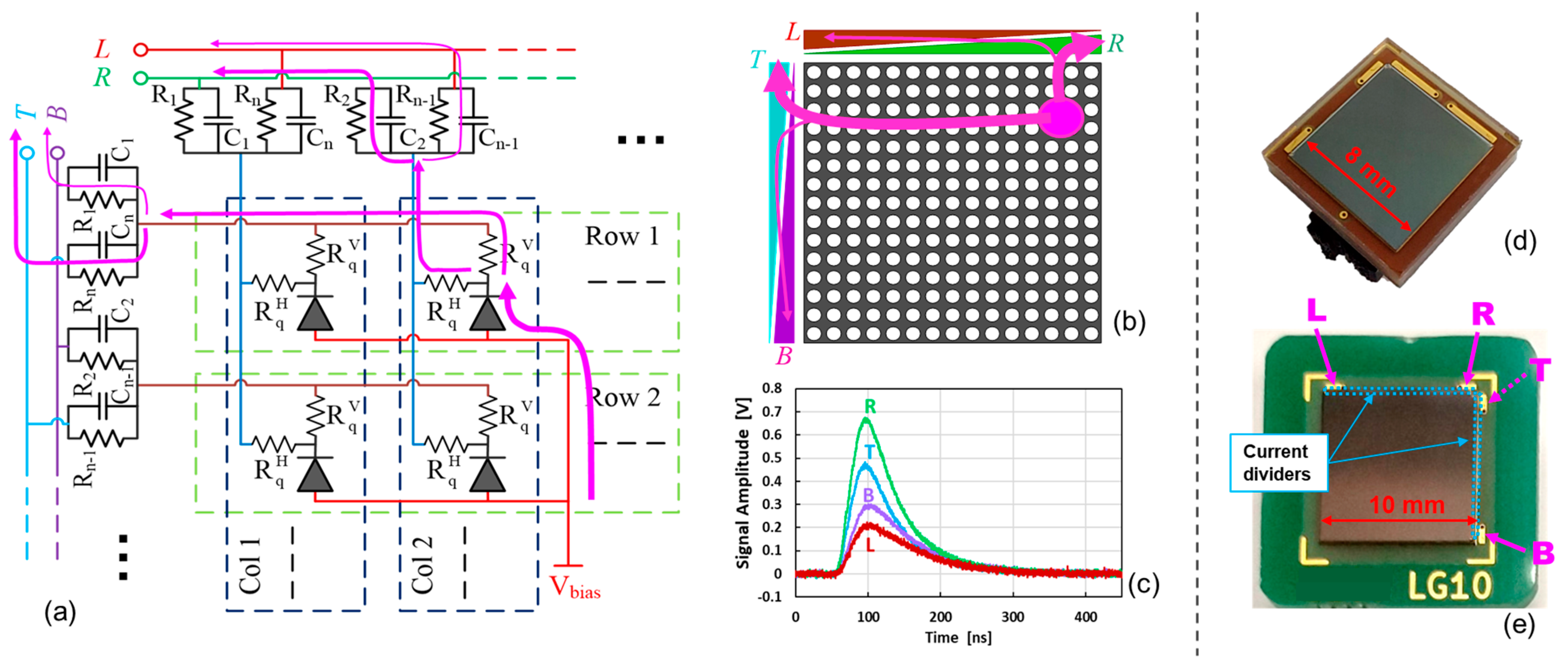
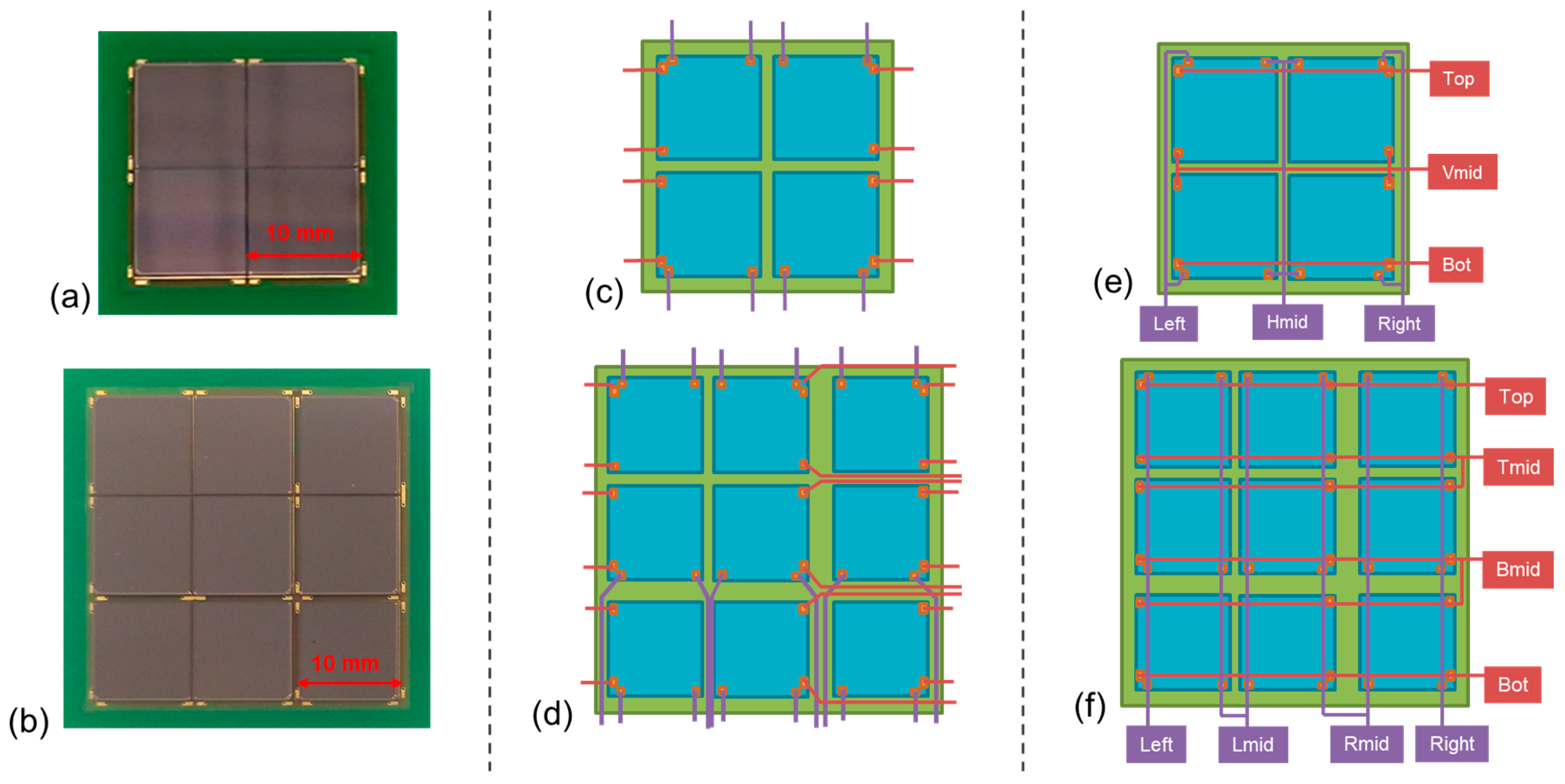
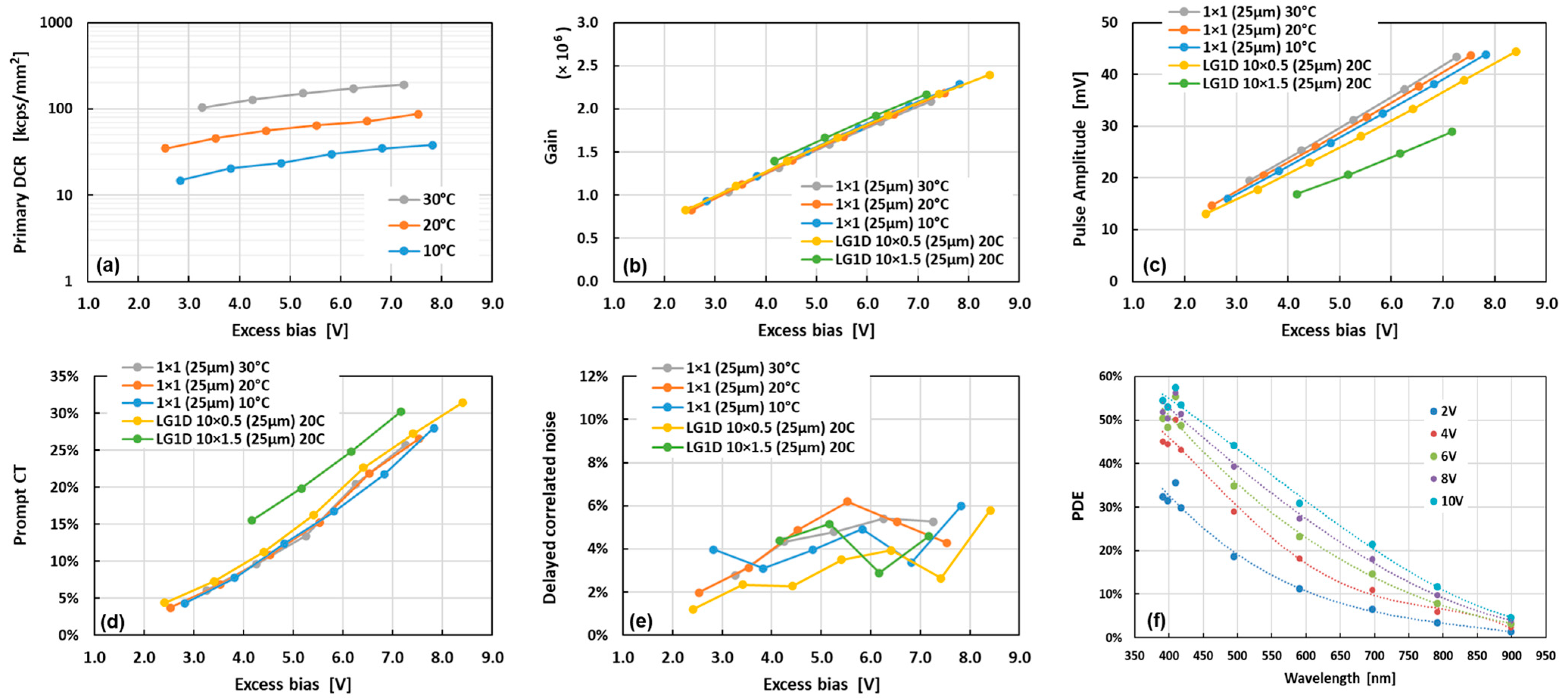
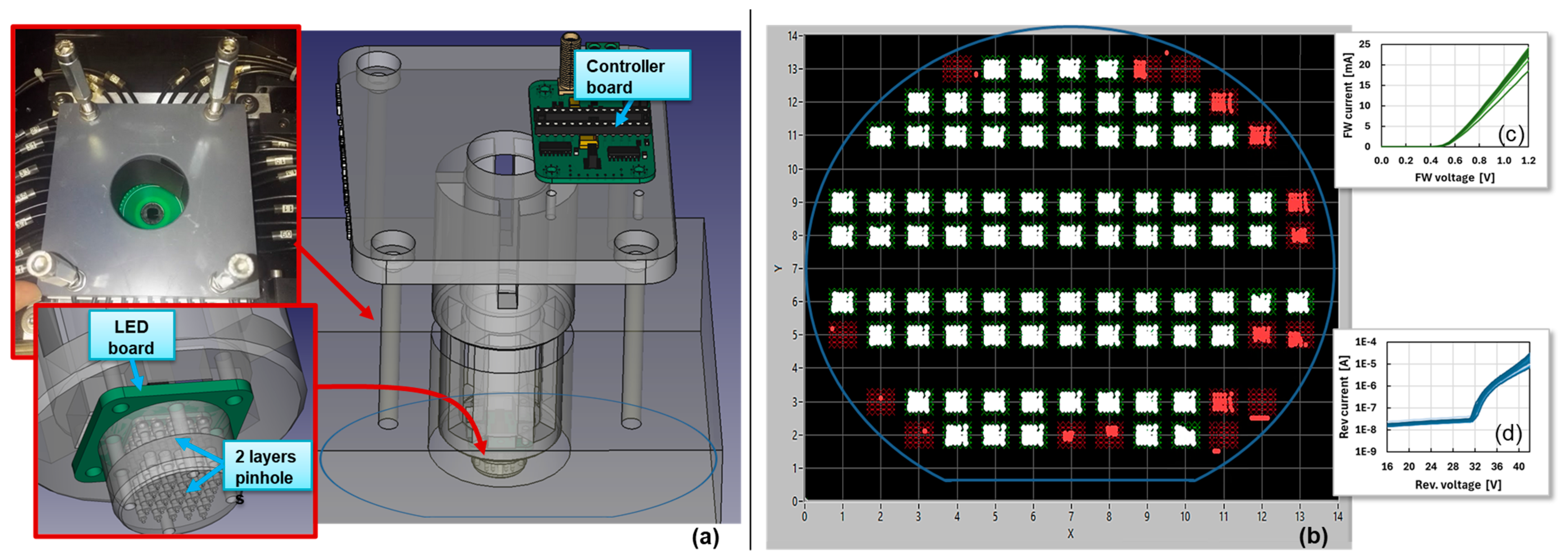
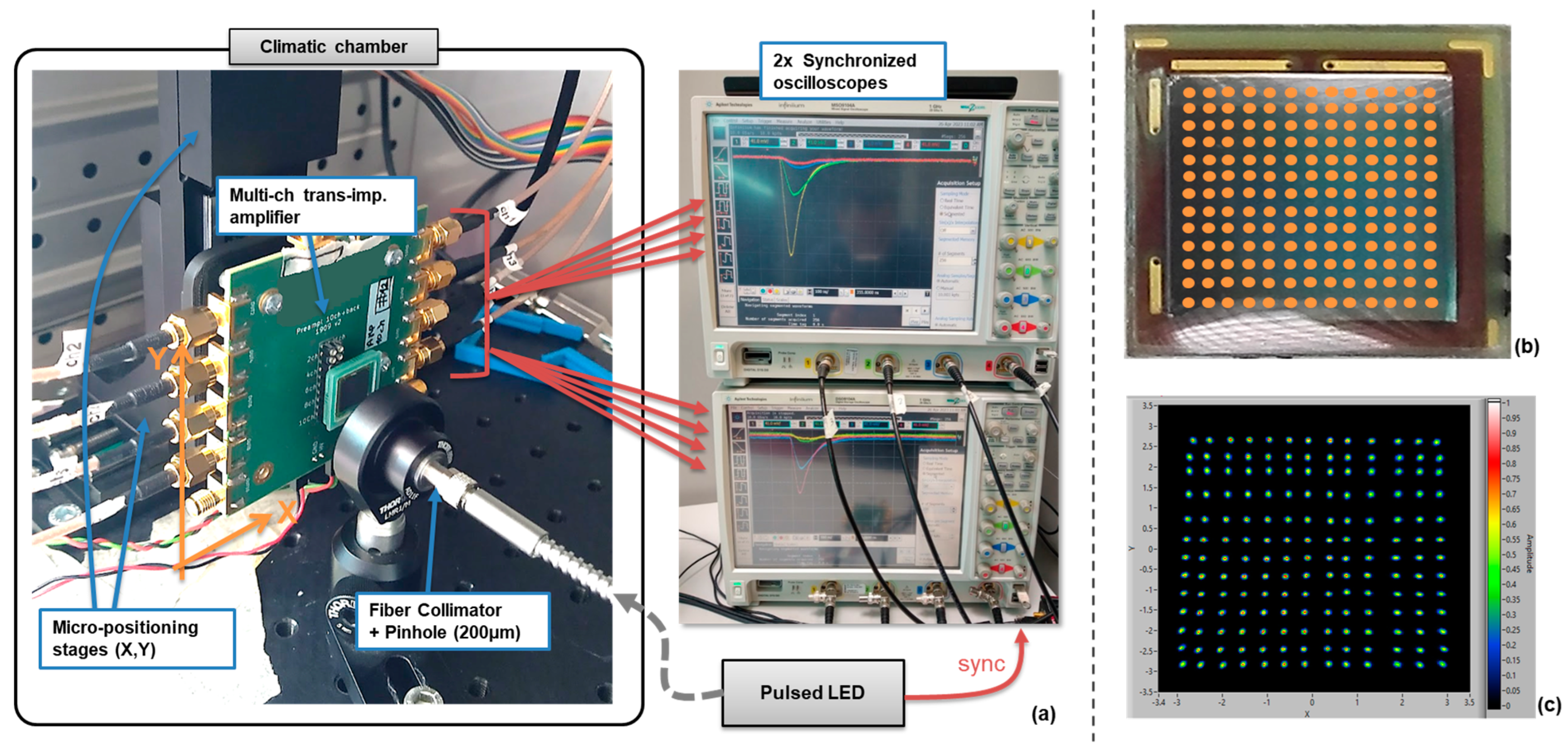





Disclaimer/Publisher’s Note: The statements, opinions and data contained in all publications are solely those of the individual author(s) and contributor(s) and not of MDPI and/or the editor(s). MDPI and/or the editor(s) disclaim responsibility for any injury to people or property resulting from any ideas, methods, instructions or products referred to in the content. |
© 2024 by the authors. Licensee MDPI, Basel, Switzerland. This article is an open access article distributed under the terms and conditions of the Creative Commons Attribution (CC BY) license (https://creativecommons.org/licenses/by/4.0/).
Share and Cite
Acerbi, F.; Merzi, S.; Gola, A. Position-Sensitive Silicon Photomultiplier Arrays with Large-Area and Sub-Millimeter Resolution. Sensors 2024, 24, 4507. https://doi.org/10.3390/s24144507
Acerbi F, Merzi S, Gola A. Position-Sensitive Silicon Photomultiplier Arrays with Large-Area and Sub-Millimeter Resolution. Sensors. 2024; 24(14):4507. https://doi.org/10.3390/s24144507
Chicago/Turabian StyleAcerbi, Fabio, Stefano Merzi, and Alberto Gola. 2024. "Position-Sensitive Silicon Photomultiplier Arrays with Large-Area and Sub-Millimeter Resolution" Sensors 24, no. 14: 4507. https://doi.org/10.3390/s24144507




